Tourism Marketing Analysis: Niche Tourism and Social Media Strategies
VerifiedAdded on 2023/01/16
|8
|1944
|32
Report
AI Summary
This report provides a comprehensive analysis of niche tourism, differentiating it from mainstream tourism and evaluating the role of Destination Management Organizations (DMOs) in marketing this segment. It explores the historical development of niche tourism, its key features, and how DMOs conduct market research, identify target markets, and promote niche tourism products. The report also critically evaluates the impact of social media on contemporary tourism marketing and branding strategies, with a specific focus on millennial tourists. It examines how social media influences their travel decisions, preferences, and the strategies used by tourism industries to engage this demographic, including the use of social media platforms, customer service, and the shift in travel agency models. The study concludes with a summary of the key findings and the implications for the tourism industry.
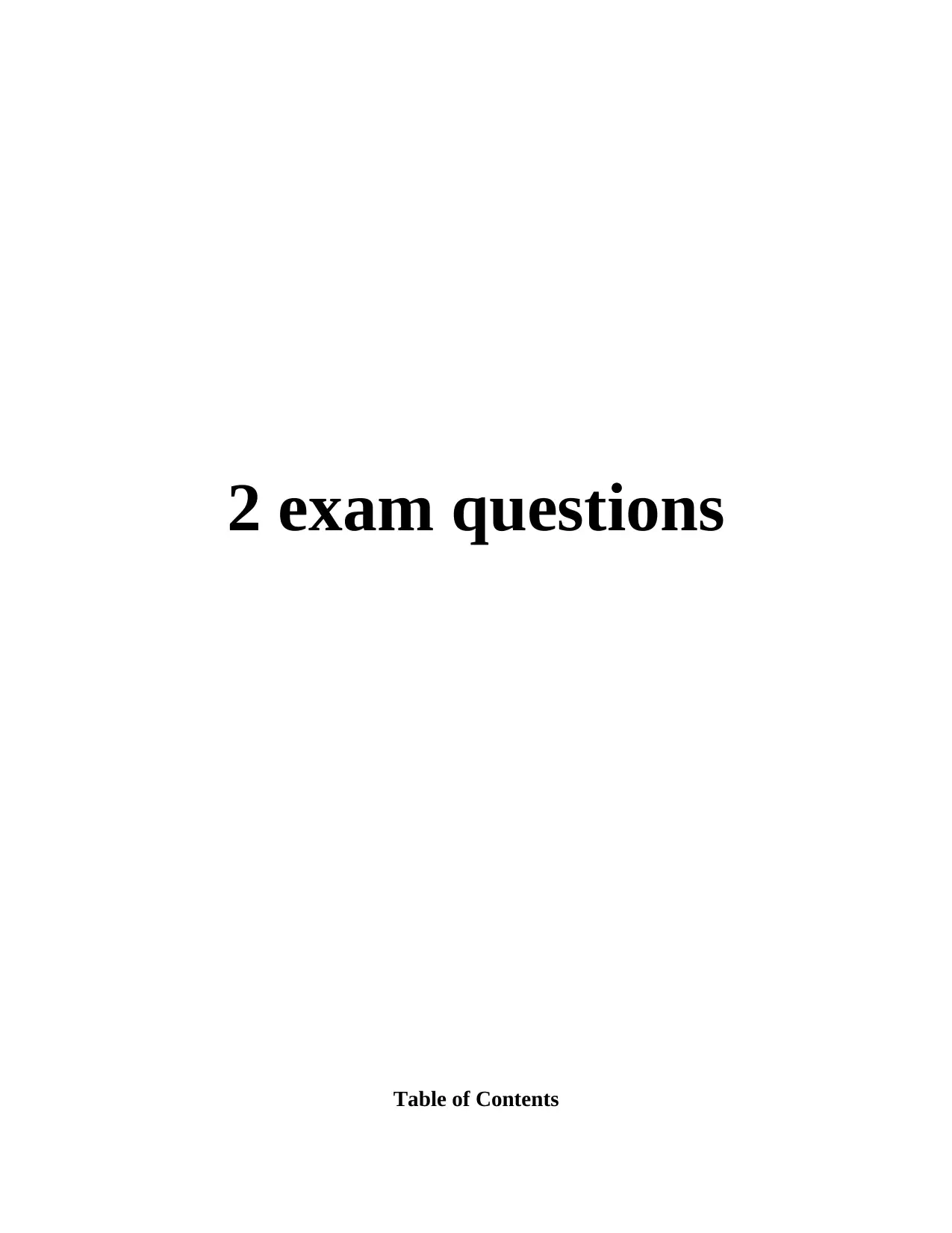
2 exam questions
Table of Contents
Table of Contents
Paraphrase This Document
Need a fresh take? Get an instant paraphrase of this document with our AI Paraphraser
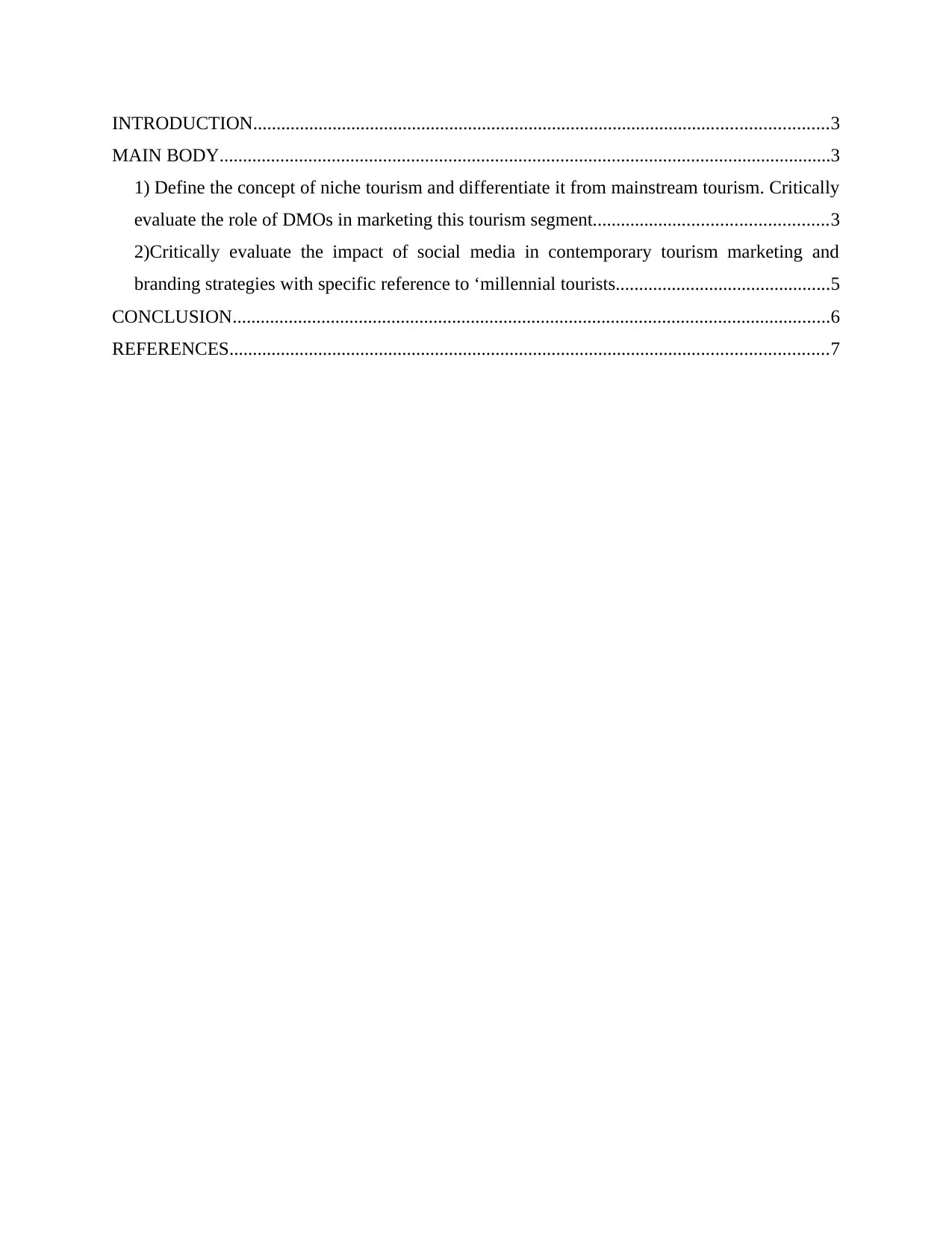
INTRODUCTION...........................................................................................................................3
MAIN BODY...................................................................................................................................3
1) Define the concept of niche tourism and differentiate it from mainstream tourism. Critically
evaluate the role of DMOs in marketing this tourism segment..................................................3
2)Critically evaluate the impact of social media in contemporary tourism marketing and
branding strategies with specific reference to ‘millennial tourists..............................................5
CONCLUSION................................................................................................................................6
REFERENCES................................................................................................................................7
MAIN BODY...................................................................................................................................3
1) Define the concept of niche tourism and differentiate it from mainstream tourism. Critically
evaluate the role of DMOs in marketing this tourism segment..................................................3
2)Critically evaluate the impact of social media in contemporary tourism marketing and
branding strategies with specific reference to ‘millennial tourists..............................................5
CONCLUSION................................................................................................................................6
REFERENCES................................................................................................................................7
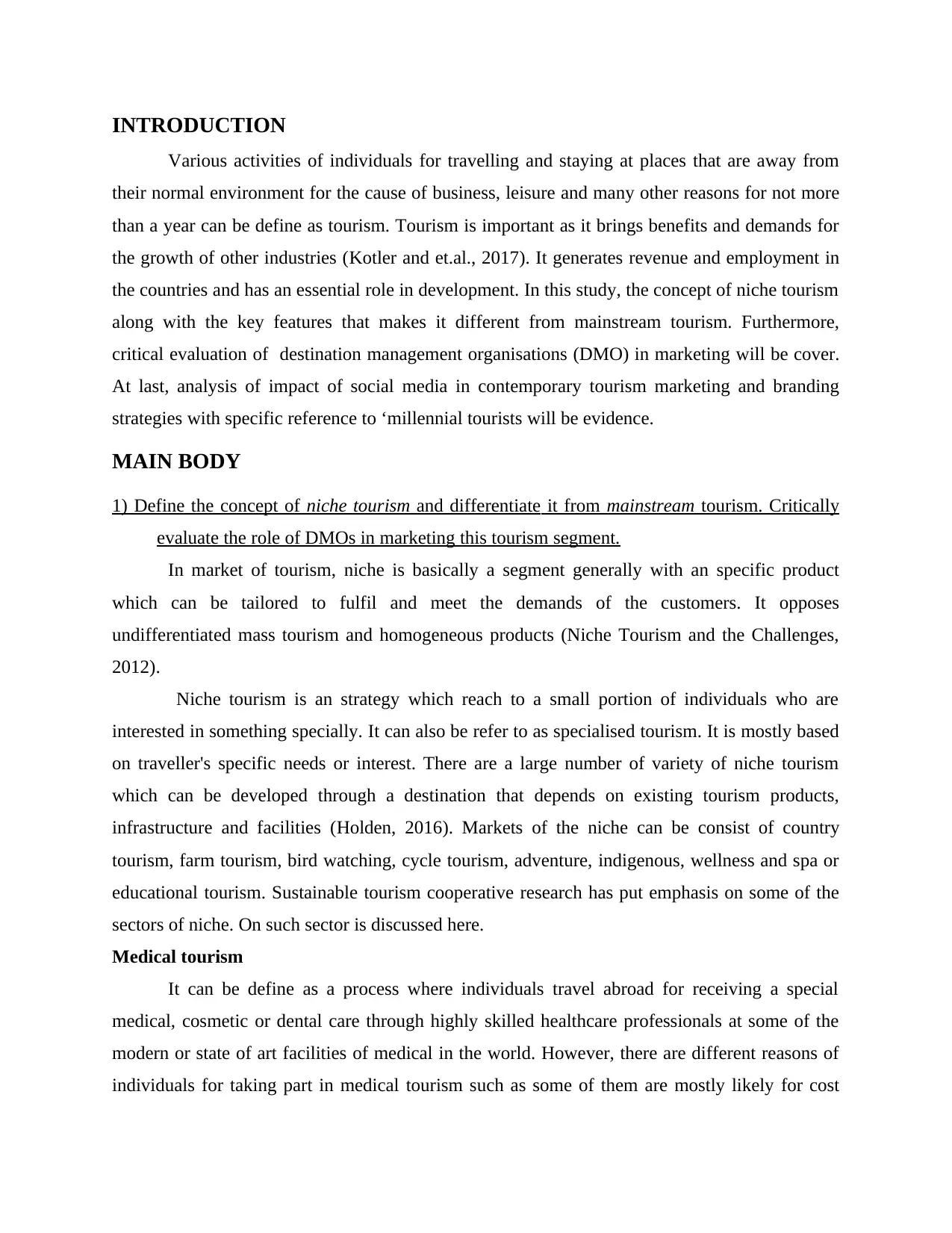
INTRODUCTION
Various activities of individuals for travelling and staying at places that are away from
their normal environment for the cause of business, leisure and many other reasons for not more
than a year can be define as tourism. Tourism is important as it brings benefits and demands for
the growth of other industries (Kotler and et.al., 2017). It generates revenue and employment in
the countries and has an essential role in development. In this study, the concept of niche tourism
along with the key features that makes it different from mainstream tourism. Furthermore,
critical evaluation of destination management organisations (DMO) in marketing will be cover.
At last, analysis of impact of social media in contemporary tourism marketing and branding
strategies with specific reference to ‘millennial tourists will be evidence.
MAIN BODY
1) Define the concept of niche tourism and differentiate it from mainstream tourism. Critically
evaluate the role of DMOs in marketing this tourism segment.
In market of tourism, niche is basically a segment generally with an specific product
which can be tailored to fulfil and meet the demands of the customers. It opposes
undifferentiated mass tourism and homogeneous products (Niche Tourism and the Challenges,
2012).
Niche tourism is an strategy which reach to a small portion of individuals who are
interested in something specially. It can also be refer to as specialised tourism. It is mostly based
on traveller's specific needs or interest. There are a large number of variety of niche tourism
which can be developed through a destination that depends on existing tourism products,
infrastructure and facilities (Holden, 2016). Markets of the niche can be consist of country
tourism, farm tourism, bird watching, cycle tourism, adventure, indigenous, wellness and spa or
educational tourism. Sustainable tourism cooperative research has put emphasis on some of the
sectors of niche. On such sector is discussed here.
Medical tourism
It can be define as a process where individuals travel abroad for receiving a special
medical, cosmetic or dental care through highly skilled healthcare professionals at some of the
modern or state of art facilities of medical in the world. However, there are different reasons of
individuals for taking part in medical tourism such as some of them are mostly likely for cost
Various activities of individuals for travelling and staying at places that are away from
their normal environment for the cause of business, leisure and many other reasons for not more
than a year can be define as tourism. Tourism is important as it brings benefits and demands for
the growth of other industries (Kotler and et.al., 2017). It generates revenue and employment in
the countries and has an essential role in development. In this study, the concept of niche tourism
along with the key features that makes it different from mainstream tourism. Furthermore,
critical evaluation of destination management organisations (DMO) in marketing will be cover.
At last, analysis of impact of social media in contemporary tourism marketing and branding
strategies with specific reference to ‘millennial tourists will be evidence.
MAIN BODY
1) Define the concept of niche tourism and differentiate it from mainstream tourism. Critically
evaluate the role of DMOs in marketing this tourism segment.
In market of tourism, niche is basically a segment generally with an specific product
which can be tailored to fulfil and meet the demands of the customers. It opposes
undifferentiated mass tourism and homogeneous products (Niche Tourism and the Challenges,
2012).
Niche tourism is an strategy which reach to a small portion of individuals who are
interested in something specially. It can also be refer to as specialised tourism. It is mostly based
on traveller's specific needs or interest. There are a large number of variety of niche tourism
which can be developed through a destination that depends on existing tourism products,
infrastructure and facilities (Holden, 2016). Markets of the niche can be consist of country
tourism, farm tourism, bird watching, cycle tourism, adventure, indigenous, wellness and spa or
educational tourism. Sustainable tourism cooperative research has put emphasis on some of the
sectors of niche. On such sector is discussed here.
Medical tourism
It can be define as a process where individuals travel abroad for receiving a special
medical, cosmetic or dental care through highly skilled healthcare professionals at some of the
modern or state of art facilities of medical in the world. However, there are different reasons of
individuals for taking part in medical tourism such as some of them are mostly likely for cost
⊘ This is a preview!⊘
Do you want full access?
Subscribe today to unlock all pages.

Trusted by 1+ million students worldwide
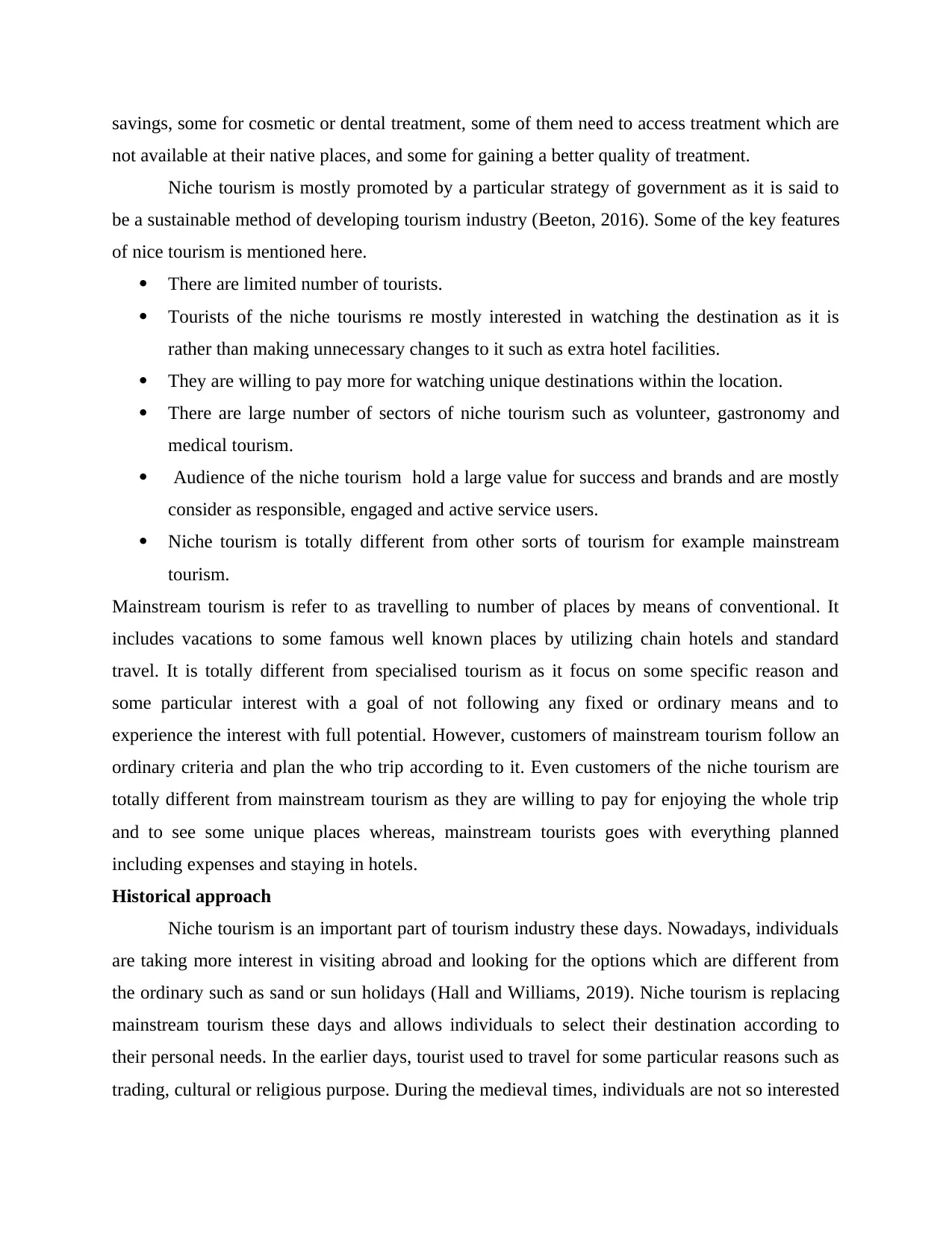
savings, some for cosmetic or dental treatment, some of them need to access treatment which are
not available at their native places, and some for gaining a better quality of treatment.
Niche tourism is mostly promoted by a particular strategy of government as it is said to
be a sustainable method of developing tourism industry (Beeton, 2016). Some of the key features
of nice tourism is mentioned here.
There are limited number of tourists.
Tourists of the niche tourisms re mostly interested in watching the destination as it is
rather than making unnecessary changes to it such as extra hotel facilities.
They are willing to pay more for watching unique destinations within the location.
There are large number of sectors of niche tourism such as volunteer, gastronomy and
medical tourism.
Audience of the niche tourism hold a large value for success and brands and are mostly
consider as responsible, engaged and active service users.
Niche tourism is totally different from other sorts of tourism for example mainstream
tourism.
Mainstream tourism is refer to as travelling to number of places by means of conventional. It
includes vacations to some famous well known places by utilizing chain hotels and standard
travel. It is totally different from specialised tourism as it focus on some specific reason and
some particular interest with a goal of not following any fixed or ordinary means and to
experience the interest with full potential. However, customers of mainstream tourism follow an
ordinary criteria and plan the who trip according to it. Even customers of the niche tourism are
totally different from mainstream tourism as they are willing to pay for enjoying the whole trip
and to see some unique places whereas, mainstream tourists goes with everything planned
including expenses and staying in hotels.
Historical approach
Niche tourism is an important part of tourism industry these days. Nowadays, individuals
are taking more interest in visiting abroad and looking for the options which are different from
the ordinary such as sand or sun holidays (Hall and Williams, 2019). Niche tourism is replacing
mainstream tourism these days and allows individuals to select their destination according to
their personal needs. In the earlier days, tourist used to travel for some particular reasons such as
trading, cultural or religious purpose. During the medieval times, individuals are not so interested
not available at their native places, and some for gaining a better quality of treatment.
Niche tourism is mostly promoted by a particular strategy of government as it is said to
be a sustainable method of developing tourism industry (Beeton, 2016). Some of the key features
of nice tourism is mentioned here.
There are limited number of tourists.
Tourists of the niche tourisms re mostly interested in watching the destination as it is
rather than making unnecessary changes to it such as extra hotel facilities.
They are willing to pay more for watching unique destinations within the location.
There are large number of sectors of niche tourism such as volunteer, gastronomy and
medical tourism.
Audience of the niche tourism hold a large value for success and brands and are mostly
consider as responsible, engaged and active service users.
Niche tourism is totally different from other sorts of tourism for example mainstream
tourism.
Mainstream tourism is refer to as travelling to number of places by means of conventional. It
includes vacations to some famous well known places by utilizing chain hotels and standard
travel. It is totally different from specialised tourism as it focus on some specific reason and
some particular interest with a goal of not following any fixed or ordinary means and to
experience the interest with full potential. However, customers of mainstream tourism follow an
ordinary criteria and plan the who trip according to it. Even customers of the niche tourism are
totally different from mainstream tourism as they are willing to pay for enjoying the whole trip
and to see some unique places whereas, mainstream tourists goes with everything planned
including expenses and staying in hotels.
Historical approach
Niche tourism is an important part of tourism industry these days. Nowadays, individuals
are taking more interest in visiting abroad and looking for the options which are different from
the ordinary such as sand or sun holidays (Hall and Williams, 2019). Niche tourism is replacing
mainstream tourism these days and allows individuals to select their destination according to
their personal needs. In the earlier days, tourist used to travel for some particular reasons such as
trading, cultural or religious purpose. During the medieval times, individuals are not so interested
Paraphrase This Document
Need a fresh take? Get an instant paraphrase of this document with our AI Paraphraser
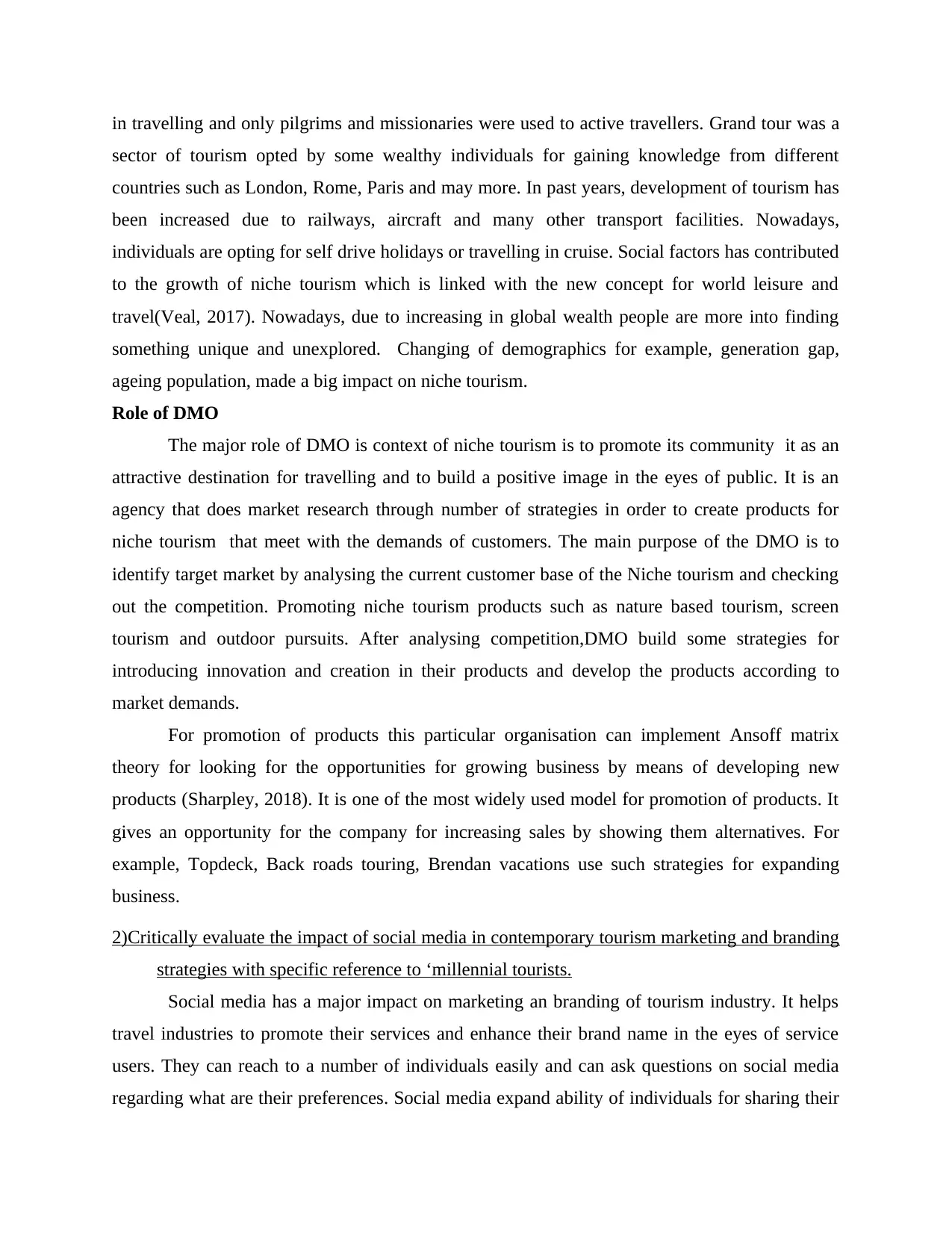
in travelling and only pilgrims and missionaries were used to active travellers. Grand tour was a
sector of tourism opted by some wealthy individuals for gaining knowledge from different
countries such as London, Rome, Paris and may more. In past years, development of tourism has
been increased due to railways, aircraft and many other transport facilities. Nowadays,
individuals are opting for self drive holidays or travelling in cruise. Social factors has contributed
to the growth of niche tourism which is linked with the new concept for world leisure and
travel(Veal, 2017). Nowadays, due to increasing in global wealth people are more into finding
something unique and unexplored. Changing of demographics for example, generation gap,
ageing population, made a big impact on niche tourism.
Role of DMO
The major role of DMO is context of niche tourism is to promote its community it as an
attractive destination for travelling and to build a positive image in the eyes of public. It is an
agency that does market research through number of strategies in order to create products for
niche tourism that meet with the demands of customers. The main purpose of the DMO is to
identify target market by analysing the current customer base of the Niche tourism and checking
out the competition. Promoting niche tourism products such as nature based tourism, screen
tourism and outdoor pursuits. After analysing competition,DMO build some strategies for
introducing innovation and creation in their products and develop the products according to
market demands.
For promotion of products this particular organisation can implement Ansoff matrix
theory for looking for the opportunities for growing business by means of developing new
products (Sharpley, 2018). It is one of the most widely used model for promotion of products. It
gives an opportunity for the company for increasing sales by showing them alternatives. For
example, Topdeck, Back roads touring, Brendan vacations use such strategies for expanding
business.
2)Critically evaluate the impact of social media in contemporary tourism marketing and branding
strategies with specific reference to ‘millennial tourists.
Social media has a major impact on marketing an branding of tourism industry. It helps
travel industries to promote their services and enhance their brand name in the eyes of service
users. They can reach to a number of individuals easily and can ask questions on social media
regarding what are their preferences. Social media expand ability of individuals for sharing their
sector of tourism opted by some wealthy individuals for gaining knowledge from different
countries such as London, Rome, Paris and may more. In past years, development of tourism has
been increased due to railways, aircraft and many other transport facilities. Nowadays,
individuals are opting for self drive holidays or travelling in cruise. Social factors has contributed
to the growth of niche tourism which is linked with the new concept for world leisure and
travel(Veal, 2017). Nowadays, due to increasing in global wealth people are more into finding
something unique and unexplored. Changing of demographics for example, generation gap,
ageing population, made a big impact on niche tourism.
Role of DMO
The major role of DMO is context of niche tourism is to promote its community it as an
attractive destination for travelling and to build a positive image in the eyes of public. It is an
agency that does market research through number of strategies in order to create products for
niche tourism that meet with the demands of customers. The main purpose of the DMO is to
identify target market by analysing the current customer base of the Niche tourism and checking
out the competition. Promoting niche tourism products such as nature based tourism, screen
tourism and outdoor pursuits. After analysing competition,DMO build some strategies for
introducing innovation and creation in their products and develop the products according to
market demands.
For promotion of products this particular organisation can implement Ansoff matrix
theory for looking for the opportunities for growing business by means of developing new
products (Sharpley, 2018). It is one of the most widely used model for promotion of products. It
gives an opportunity for the company for increasing sales by showing them alternatives. For
example, Topdeck, Back roads touring, Brendan vacations use such strategies for expanding
business.
2)Critically evaluate the impact of social media in contemporary tourism marketing and branding
strategies with specific reference to ‘millennial tourists.
Social media has a major impact on marketing an branding of tourism industry. It helps
travel industries to promote their services and enhance their brand name in the eyes of service
users. They can reach to a number of individuals easily and can ask questions on social media
regarding what are their preferences. Social media expand ability of individuals for sharing their
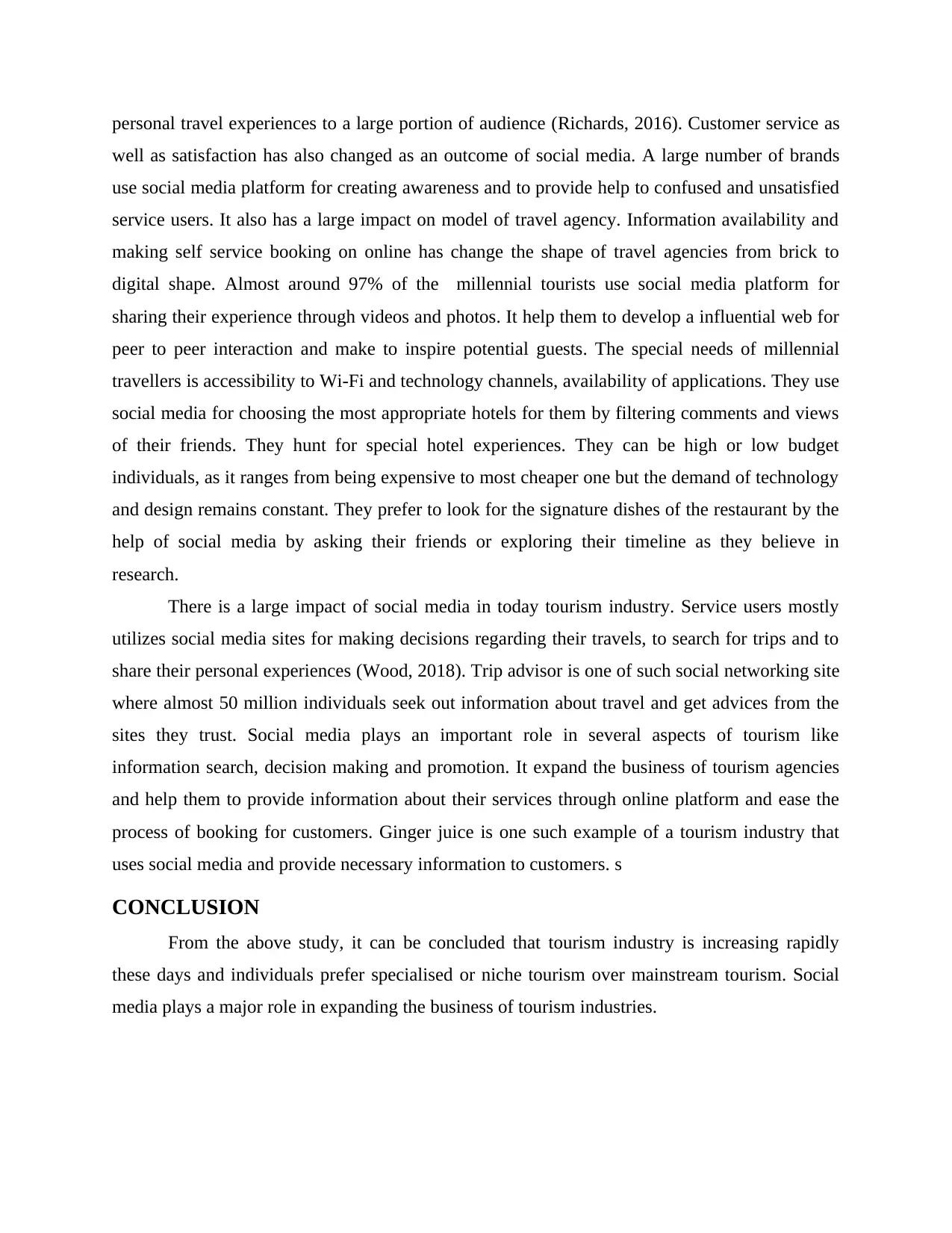
personal travel experiences to a large portion of audience (Richards, 2016). Customer service as
well as satisfaction has also changed as an outcome of social media. A large number of brands
use social media platform for creating awareness and to provide help to confused and unsatisfied
service users. It also has a large impact on model of travel agency. Information availability and
making self service booking on online has change the shape of travel agencies from brick to
digital shape. Almost around 97% of the millennial tourists use social media platform for
sharing their experience through videos and photos. It help them to develop a influential web for
peer to peer interaction and make to inspire potential guests. The special needs of millennial
travellers is accessibility to Wi-Fi and technology channels, availability of applications. They use
social media for choosing the most appropriate hotels for them by filtering comments and views
of their friends. They hunt for special hotel experiences. They can be high or low budget
individuals, as it ranges from being expensive to most cheaper one but the demand of technology
and design remains constant. They prefer to look for the signature dishes of the restaurant by the
help of social media by asking their friends or exploring their timeline as they believe in
research.
There is a large impact of social media in today tourism industry. Service users mostly
utilizes social media sites for making decisions regarding their travels, to search for trips and to
share their personal experiences (Wood, 2018). Trip advisor is one of such social networking site
where almost 50 million individuals seek out information about travel and get advices from the
sites they trust. Social media plays an important role in several aspects of tourism like
information search, decision making and promotion. It expand the business of tourism agencies
and help them to provide information about their services through online platform and ease the
process of booking for customers. Ginger juice is one such example of a tourism industry that
uses social media and provide necessary information to customers. s
CONCLUSION
From the above study, it can be concluded that tourism industry is increasing rapidly
these days and individuals prefer specialised or niche tourism over mainstream tourism. Social
media plays a major role in expanding the business of tourism industries.
well as satisfaction has also changed as an outcome of social media. A large number of brands
use social media platform for creating awareness and to provide help to confused and unsatisfied
service users. It also has a large impact on model of travel agency. Information availability and
making self service booking on online has change the shape of travel agencies from brick to
digital shape. Almost around 97% of the millennial tourists use social media platform for
sharing their experience through videos and photos. It help them to develop a influential web for
peer to peer interaction and make to inspire potential guests. The special needs of millennial
travellers is accessibility to Wi-Fi and technology channels, availability of applications. They use
social media for choosing the most appropriate hotels for them by filtering comments and views
of their friends. They hunt for special hotel experiences. They can be high or low budget
individuals, as it ranges from being expensive to most cheaper one but the demand of technology
and design remains constant. They prefer to look for the signature dishes of the restaurant by the
help of social media by asking their friends or exploring their timeline as they believe in
research.
There is a large impact of social media in today tourism industry. Service users mostly
utilizes social media sites for making decisions regarding their travels, to search for trips and to
share their personal experiences (Wood, 2018). Trip advisor is one of such social networking site
where almost 50 million individuals seek out information about travel and get advices from the
sites they trust. Social media plays an important role in several aspects of tourism like
information search, decision making and promotion. It expand the business of tourism agencies
and help them to provide information about their services through online platform and ease the
process of booking for customers. Ginger juice is one such example of a tourism industry that
uses social media and provide necessary information to customers. s
CONCLUSION
From the above study, it can be concluded that tourism industry is increasing rapidly
these days and individuals prefer specialised or niche tourism over mainstream tourism. Social
media plays a major role in expanding the business of tourism industries.
⊘ This is a preview!⊘
Do you want full access?
Subscribe today to unlock all pages.

Trusted by 1+ million students worldwide
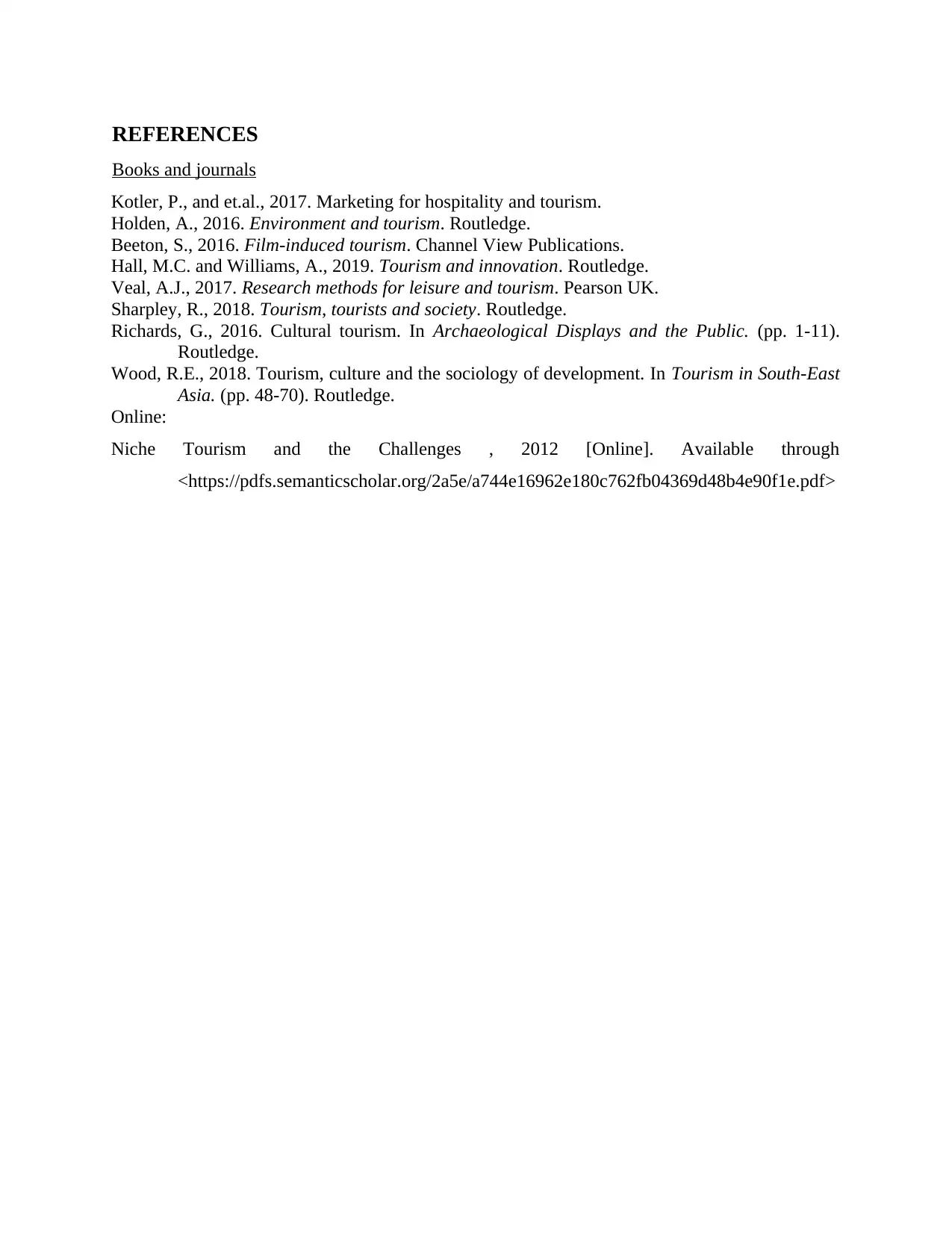
REFERENCES
Books and journals
Kotler, P., and et.al., 2017. Marketing for hospitality and tourism.
Holden, A., 2016. Environment and tourism. Routledge.
Beeton, S., 2016. Film-induced tourism. Channel View Publications.
Hall, M.C. and Williams, A., 2019. Tourism and innovation. Routledge.
Veal, A.J., 2017. Research methods for leisure and tourism. Pearson UK.
Sharpley, R., 2018. Tourism, tourists and society. Routledge.
Richards, G., 2016. Cultural tourism. In Archaeological Displays and the Public. (pp. 1-11).
Routledge.
Wood, R.E., 2018. Tourism, culture and the sociology of development. In Tourism in South-East
Asia. (pp. 48-70). Routledge.
Online:
Niche Tourism and the Challenges , 2012 [Online]. Available through
<https://pdfs.semanticscholar.org/2a5e/a744e16962e180c762fb04369d48b4e90f1e.pdf>
Books and journals
Kotler, P., and et.al., 2017. Marketing for hospitality and tourism.
Holden, A., 2016. Environment and tourism. Routledge.
Beeton, S., 2016. Film-induced tourism. Channel View Publications.
Hall, M.C. and Williams, A., 2019. Tourism and innovation. Routledge.
Veal, A.J., 2017. Research methods for leisure and tourism. Pearson UK.
Sharpley, R., 2018. Tourism, tourists and society. Routledge.
Richards, G., 2016. Cultural tourism. In Archaeological Displays and the Public. (pp. 1-11).
Routledge.
Wood, R.E., 2018. Tourism, culture and the sociology of development. In Tourism in South-East
Asia. (pp. 48-70). Routledge.
Online:
Niche Tourism and the Challenges , 2012 [Online]. Available through
<https://pdfs.semanticscholar.org/2a5e/a744e16962e180c762fb04369d48b4e90f1e.pdf>
Paraphrase This Document
Need a fresh take? Get an instant paraphrase of this document with our AI Paraphraser

1 out of 8
Related Documents
Your All-in-One AI-Powered Toolkit for Academic Success.
+13062052269
info@desklib.com
Available 24*7 on WhatsApp / Email
![[object Object]](/_next/static/media/star-bottom.7253800d.svg)
Unlock your academic potential
Copyright © 2020–2025 A2Z Services. All Rights Reserved. Developed and managed by ZUCOL.





